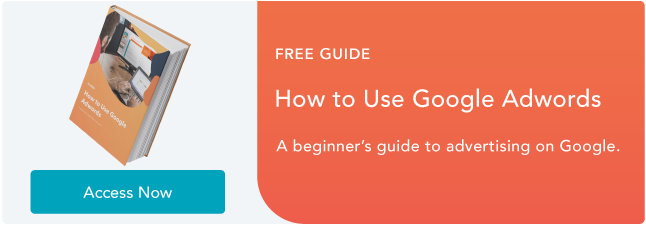Even though I think Google AdWords is one of the greatest advertising systems there is, I’m the first to admit that Google makes it really easy to waste your money. A lot of the default settings in AdWords are there to maximize your reach -- which is great if you want the highest possible number of clicks.

But remember: this is pay-per-click marketing, and those click costs are going to add up fast if you cast a really wide net.
The problem is, when you reach more people, you’re generally sacrificing relevance. Many of the people who click your ads aren’t going to be your ideal customer, and, in the end, that hurts your ROI.
The best way to increase your ROI from AdWords is to take measures that whittle down your audience to the most relevant potential customers. Luckily, there are lots of ways to do this in AdWords -- you just have to know what they are.
Here are the top-six ways to filter out unwanted clicks and reduce your wasted spend in AdWords.
1) Negative Keywords
Negative keywords are the classic way to filter out unwanted, irrelevant clicks on your AdWords ads. A negative keyword is basically the opposite of a regular keyword -- instead of telling Google “Show my ads when someone searches on this term,” you’re telling Google not to show your ads when this term is part of the search query.
Let’s say, for example, that you sell fish tanks, fish food, and related pet fish supplies. You wouldn’t want your ads to show up for people looking for fish recipes or fish restaurants or fish food trucks. So, “recipe," “restaurant,” and “truck” would go on your negative keyword list.
Building out a solid negative keyword list will save you a lot of money in worthless clicks that will never convert. But we’ve found that up to 25% of advertisers aren’t using any negative keywords at all. Bad idea!
There are two methods for finding negative keyword ideas:
- Reactive: Keep an eye on your Search Query Reports in AdWords -- these are the real terms that trigger clicks on your ads. If you see something irrelevant to your business, add that term as a negative keyword.
- Proactive: Use a negative keyword tool to get ideas before they cost you money.

2) Modified Broad Match
Another way to filter out unwanted impressions and clicks is to swap out broad match (the default keyword match type on Google) for modified broad match.

Broad match is the least restrictive match type, meaning Google attempts to match your ad against the greatest possible number of queries. So if you bid on the keyword “fish food” with broad match, it’s possible that your ad would show up for searches like “fish recipes” or “seafood restaurants,” because Google figures that only one term in the keyword needs to match the search query and it uses synonym matching pretty aggressively.
Negative keywords are one way to fight this over-aggressive matching, but another way is to make better use of the modified broad match type.
With modified broad, you append a plus sign to any terms in your keyword that must appear in the search query. So if you bid on the keyword “+fish +tank” in Google, your ad will only show up for queries that include both “fish” and “tank,” like “tropical fish tank” or “tank for large fish.” You won’t get impressions or clicks for terms like “tank top” and “fish recipes.” Thus, your clicks are going to be more qualified.
3) Narrower Context Targeting
Another way to make sure your clicks are relevant is to focus on user context – that is, only showing your ads to people in the right place at the right time.
With AdWords Enhanced Campaigns, you can adjust your bids up or down depending on a user's:
- Location: Use geo-targeting to bid more in certain areas -- for example, within a 50-mile radius of your store -- and prevent your ads from showing in locations that your business doesn’t serve.
- Time of search: This is also known as dayparting. Turn off ads outside your business hours or bid less on the weekends if those clicks are less profitable.
- Device: Adjust bids up or down depending on whether the search is using a desktop or mobile device. (Lots of advertisers assume that mobile searches are worth less, but depending on your business, the exact opposite could be true.)
By fine-tuning when and where your ads show up, you can better control the context in which users see your ads, so you focus your PPC spending on the audiences that are most likely to convert into sales or leads.
4) Mobile Optimization
If you are bidding on mobile searches (hot tip: after the upgrade to Enhanced Campaigns, you almost definitely are), you can reduce wasted spend by making sure you have enabled mobile-optimized ads.
Mobile-preferred text ads allow you to tailor the user experience for mobile users. You can include mobile-specific calls-to-action and direct users to mobile-optimized landing pages. Almost as important for marketers who are constantly seeking to improve their metrics, you can A/B test mobile text ads against each other in an apples-to-apples comparison to improve your overall account performance.

This is vital because mobile users behave differently from non-mobile users. For example, they are more likely to place a phone call than fill out a form. So use mobile-specific ad extensions, like click-to-call extensions. (As a bonus, ad extensions tend to increase your CTR and Quality Score, which save you even more money.)
5) Smarter Bid Management
You can also make better use of your spend by adjusting your bid management strategies. There are lots of theories regarding the best way to manage bids, but at a high level, you want to:
- Raise bids on your best-performing keywords: If you have keywords with high CTR and Quality Score that are converting at a profit, bid more on them! This is just common sense.
- Lower bids on weaker keywords: Look for terms that get lots of clicks but not many conversions. These low-converting keywords are a big source of wasted spend.
You might also want to watch out for AdWords’ automated bid management feature -- most likely, the automated bids won’t make optimal use of your spend.
6) Turn Conversion Tracking On!
You’d be amazed how many advertisers don’t follow the simple best practice of turning on conversion tracking. If you’re not tracking conversion in AdWords, you really have no idea how much money you’re wasting.
Make sure your landing pages have conversion tracking enabled so you can measure what’s working and what isn’t, then funnel your marketing spend toward the keywords and campaigns that deliver ROI.
What methods do you use to lower your spend on AdWords? Let us know in the comments below!
This is a guest post written by Larry Kim. Larry is the founder and CTO of WordStream, provider of the 20 Minute PPC Work Week and the AdWords Grader. You can follow him on Twitter and Google+.
Image credit: 401(K) 2012



![The Ultimate Guide to Google Ads [Examples]](https://www.hubspot.com/hubfs/adwords-ppc_4.webp)






